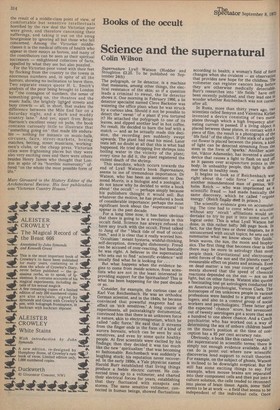Squalor and Splendour
Marc Girouard
The Victorian City, edited by H. J. Dyos and Michael Wolff, two volumes (Routledge and Kegan Paul E27,00)
In .1801, 80 per cent of the people of Great Britain lived in the country or in small towns and only 20 per cent in towns of 10,000 or over. , By 1901 77 per cent was urban and Only 25 Derr cent rural. England was the first
country iii the world to experience this dramatic and indeed traumatic reversal, and to attempt to cope with the appalling problems it brought with it. Professors Dyos and Wolff marshall a team of thirty-eight collaborators to discuss the Victorian city in two heftily handsome volumes at a price that will break the heart of all Victorian enthusiasts. In its size, its price, its scope, and in the scholarship and research that have gone into it this is a formidable and fascinating work.
It gives many insights and much information, but it does not give, what in view of its size one might expect, anything approaching a comprehensive treatment of its subject. One is left wondering whether the fields it covers and the fields it omits represent the pattern of current research or simply the predilection of its editors. In spite of some interesting general essays and one or two specialist ones on subjects such as architecture or the railways, the preponderant theme of the book is not the Victorian city but the Victorian city poor. This was a theme that haunted the Victorians themselves, both those who brought it into the open and those who resolutely stuffed it in a cupboard. They were justifiably haunted; it wasn't only the poverty in itself, the squalor, the excrement, the drunkenness, the overwork, the lack of focid and hope, that was appalling, but the contrasting comfort of the well-to-do, and all too often the hypocrisy that accompanied it: the stucco splendours and green squares of Ladbroke Grove only a few yards from the filth of the
Piggeries and Potteries' where the average life expectancy was eleven years and seven months; the top-hatted businessmen smugly gliding in comfortable railway carriages from comfortable suburbs to mahoganied offices across the in-between land where the people from whom much of their wealth derived were living in hovels. Engels as a young man analysed with
knowledge and passion the contrast between the prosperous outer face and behind-scenes poverty of Manchester. Much of The Victorian City is devoted to going behind what Henry James called "the vast smug surface" and examining the-life of the urban poor with a -mixture of indignation, statistics, and sympathy — nowhere with more sympathy than in Raphael Samuel's essay on 'Comers and Goers' a wonderfully evocative account of the migratory poor, the gipsies, masons, navvies, travelling salesmen and others who roamed the country in the summer and wintered in the town.
Meanwhile the pall of smoke and filth that hung over all large Victorian cities tended to be seen by the more sensitive of the middleclasses as a symbol of something that either had to be fled from or destroyed. By and large, it is as escapists, missionaries, or reformers that the middle classes appear in The Victorian City: as escapists who, like the majority of Victorian poets and artists, turned their backs on the modern city and dreamed of rural or medieval innocence; as mis,sionaries coming down to the slums to do good; as reformers whose aim was to dissolve the wicked city and remould it with a rustic accent. As actual inhabitants of the city they make a very small showing; the suburbs appear primarily as a foil to the slums rather than as a way of life on their own; except in the architectural articles the City and other mercantile centres don't appear at all; nor for that matter does London's West End, or the clubs and hotels that every city produced to a greater or lesser degree, and London most of all.
The ommissions are certainly curious. Perhaps they stem partly from historical accident; it was city poverty that worried or scared the Victorians themselves and it is therefore for poverty that statistics are most easily available. Perhaps, in an odd way, it is
the result of a middle-class point of view, of comfortable but sensitive intellectuals horrified by the raw deal the Victorian poor were given, and therefore canonising their sufferings, and taking it out on the smug bourgeoisie by ignoring all but those who felt concerned. Among the Victorian middleclasses it is the medical officers of health who appear in their essays as heroes, and many of the contributors can be seen as their spiritual successors — enlightened collectors of facts, appalled by what they see but also puzzled. For the Victorian poor voted with their feet by flocking from the country to the towns in enormous numbers and, in spite of all the horrors, showing no inclination to leave them. Two separate essays quote H. L. Smith's analysis of the poor being brought to London by "the contagion of numbers, the sense of something going on, the theatres and the music halls, the brightly lighled streets and busy crowds — all, in short, that makes the difference between the Mile End fair on a Saturday night, and a dark and muddy country lane." And yet, apart from Brian Harrison's excellent essay on pubs, the book contains curiously little to illustrate that 'something going on' that made life endurable — nothing for instance on music-halls, circuses, fairs, street-markets, boxing matches, betting, street musicians, workingmen's clubs, or the cheap press. Victorian cities were frightening places but they were also very exciting ones and there were others besides Henry James who thought that London in spite of its "horrible numerosity" offered "on the whole the most possible form of life."
Marc Girouard is the History Editor of the Architectural Review. His last publication was 'Victorian Country Houses.'



































 Previous page
Previous page